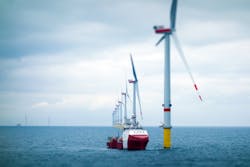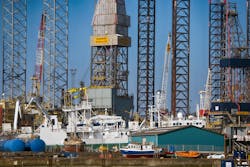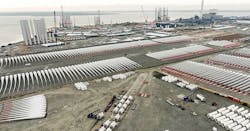In March 2021, the Biden administration announced a target goal for offshore wind energy in the U.S. of 30 GW by 2030 and 110 GW by 2050. States up and down the East Coast already have planned or committed to producing as much as 40 GW of offshore windpower (OSW) — enough to power approximately 13 million homes — by 2040. Virginia and North Carolina are on the road to having their state utilities build OSW generation. Many other states, including Maryland, New Jersey, New York, Connecticut, Rhode Island and Massachusetts, are relying on third parties for construction and operation of OSW facilities.
The U.S. OSW industry is in the nascent stages of developing a domestic supply chain because of market demand driven by policy directives, declining costs and sociopolitical initiatives for energy system transitions. OSW technology is scalable and cost competitive. It can be deployed at a pace fast enough to exceed the replacement rate of retiring thermal generation — and potentially at a pace required for effective climate-change mitigation.
To understand the range and magnitude of the needed infrastructure to support the growth of OSW, the Center for Research in Wind (CReW) at the University of Delaware conducted a study of the supply infrastructure needed to achieve the U.S.’s OSW power generation targets, published in the April 2022 issue of the Journal of Energy Policy.
OSW Power Evolution
The world’s first OSW project, Vindeby, was built in 1991 off the Danish Island of Lolland and operated through 2017. Vindeby consisted of 11 turbines mounted on the seafloor, in shallow waters near the shore. Each turbine produced 0.45 MW power at peak, with the tower reaching 37;m (121 ft) from waterline to hub and a blade length of 17m (56 ft). The heaviest component lifted, the nacelle, weighed 27 tons; the tower was 20;tons and each blade only 2.2tons. Eleven such turbines made up the OSW project of 4.95 MW. Despite rough weather, the entire project was installed in 11 days. The turbines were manufactured in factories built for land-based wind power, moved by conventional transport and easily deployed from a conventional port using nonspecialized marine construction vessels.
By contrast, today’s new commercially competitive OSW projects range from 800 MW to 1.2 GW — more than 160 times the power of Vindeby. Modern projects specify turbines with capacities of 12 MW to 14 MW, with hub heights of 138 m (453 ft) and blades of 107 m (351 ft) each. The nacelles weigh 600 tons and each blade is 55 tons, thus requiring the use of a heavy-lift, ocean-going crane. Assuming a 1-GW OSW project uses 12-MW turbines, 83 turbines of such technical specifications would be deployed.
Given the evolution of turbine and project technology, the original infrastructure specifications that were sufficient to build Vindeby are far from adequate for a modern OSW project. Now, a 1-GW project needs a port that can receive, store, move, assemble, load onto an installation vessel — with a deck capable of accommodating component dimensions and a crane capable of the required lifts — and deploy 83 large turbines at sea over the span of 18 months to 24 months. Today’s port needs to meet more challenging area, access, handling and load-bearing specifications.
Infrastructure Needed
As turbines and projects have grown by orders of magnitude, the underlying physical infrastructure and supply chain have become larger and more specialized. Today, new project components are built in specialized factories, as opposed to onshore wind factories that have been repurposed for OSW. As there currently is no robust supply chain in the U.S. to support the nascent industry, OSW project developers are reckoning with how to work around the lack of U.S.-based infrastructure.
Importing all components from overseas runs into several problems:
1. Europe’s OSW manufacturing facilities already are strained to meet their own OSW goals.
2. Developers have been hesitant to rely on early-stage Asian manufacturing in which they do not yet have confidence.
3. As the components are very large, additional loading and unloading for trans-ocean shipping adds cost and logistics.
This logic along with the Biden administration’s employment priorities lead toward investing in and supporting U.S.-based manufacturing of OSW components. Substantial investments in manufacturing will be required to meet state and federal targets, but the known targets give investors visibility into the pipeline of project orders, and the corresponding return on investments in component manufacturing.
U.S. investments can be further facilitated by incentives to build manufacturing in the U.S., as has been pursued by both the federal government and several states. The University of Delaware’s CReW does not treat manufacturing as a significant barrier, as public policies (state and federal) already have created an OSW power market and are incentivizing U.S.-based manufacturing.
Types of OSW Ports
Over the life cycle of an OSW power project, the Global Wind Energy Council identifies four types of OSW-related ports:
1. Small oceanic ports for survey vessels
2. Manufacturing ports
3. Marshaling ports
4. Operations and maintenance ports.
Based on its comparison and analysis of the four OSW port types, and especially the capacity to handle larger wind turbines and project sizes, the CReW proposes that marshaling ports, that is, ports where all components are collected, stored and made ready just prior to loading out to a wind project at sea, hold the most promise for expanding supply chain capacity, reducing the cost of construction and, thus, ultimately further reducing the cost of electricity from OSW.
Whereas the other three port types can be rebuilt from old commercial ports, the marshaling port’s demanding requirements indicate the best future marshaling ports may not be at ports that exist today.
Additionally, while clearer thresholds of business viability may exist for the other port types, expansion of marshaling ports is a more difficult venture. Finally, capitalizing on the promise of expanded supply chain capacity and meeting U.S. offshore wind power generation targets without burdensome and costly logistical complexity depends on early port development, that is, by 2025.
Marshaling Ports
Marshaling ports provide a staging ground where large turbine parts can be housed, partially assembled or readied before being loaded onto vessels and delivered to a wind project at sea. The Port of Esbjerg in Denmark is a highly successful marshaling port. The port marshaled approximately 80% of the 15-GW OSW capacity installed in Europe over the 16 years up to the time of this picture in 2017. At the time of this photograph, the port was approximately 440 acre (178 hectare) of land area devoted to marshaling for the OSW industry. The turbines shown are one-third to one-half the capacity (in megawatts) of those expected to be used going forward in the U.S.
As discussed in the CReW’s study, all existing and planned U.S. marshaling ports together are approximately half the area of Esbjerg, yet OSW commitments by U.S. states demand deploying 2.5 times as many megawatts of installations in the same number of years. The desirable size and design of Esbjerg is validated by the project planners and vessel operators who prefer to use it over closer marshaling ports; Esbjerg often is used to marshal projects 500km (310 miles) away from the port.
Finding and developing sufficiently large land areas adjacent to the water, with no bridges or other obstructions to the sea, can be challenging. Land adjacent to water is highly valued, and much has been developed as residential property, marketed for water view and access to water recreation. Concurrently, remaining undeveloped land may be environmentally valuable, restricted wetlands or too soft to make high weight-bearing requirements problematic.
Despite these constraints, states buying OSW-generated electricity often push for a port within their state because of the potential economic benefits and job-creation opportunities, which leads to a proliferation of U.S. plans for ports that are tiny relative to existing European marshaling ports. While small marshaling ports may be useful for the first few projects, they exacerbate logistical inefficiencies, raise costs, and likely will not be useful for OSW as turbine sizes grow and technology evolves to more in-port assembly and floating wind.
Unlike Europe, the U.S. has just one operational marshaling port: the New Bedford Marine Commerce Terminal, in New Bedford, Massachusetts. This port is 29 acre (11.7 hectare) and was designed originally for the Cape Wind project, with turbines of 3.6 MW each.
Now, New Bedford has been leased to help marshal the significantly larger 800-MW Vineyard Wind 1 project, with turbines of 13 MW each. Because of the limited port area, parts will have to be marshaled among three regional ports to accommodate the project’s size and target power-on date. This increases the cost, logistical complexity and time of the project’s installation, while also complicating port availability for other projects set to be deployed within the same region and time frame.
The need to use three ports for a single project demonstrates the shortage of U.S. marshaling ports of sufficient area for modern turbine and project sizes. The April 2022 report also examined the capital and cost allocation needed for OSW-related infrastructure to eliminate the foreseeable OSW bottleneck.
Sara B. Parkison is a Knauss Fellow currently working with the Bureau of Ocean Energy Management’s Office of Environmental Programs as an underserved community engagement advisor. Previously, she was senior policy analyst with the Electric Vehicle Research & Development Group within the University of Delaware’s Center for Research in Wind. As a Ph.D. candidate within the University of Delaware’s college of earth, ocean and environment, her doctoral research focuses on multi-scalar energy system transitions and the underlying interface of science, technology and sociopolitical dynamics. She received her bachelor’s degree in political science and public policy at St. Mary’s Public Honors College of Maryland.
Willett Kempton is a professor at the University of Delaware, affiliated professor at Technical University of Denmark (DTU) and chair of the Technical Advisory Board for Nuvve Corp. Kempton also is the founding director, and now associate director, of the Center for Research in Wind and inventor of the grid-integrated vehicles (GIV) with vehicle-to-grid (V2G) power, holding four patents. He writes and lectures widely on advanced research and development on offshore wind power, GIV and V2G.
Offshore Wind Advantages
1. Offshore wind generation produces near-zero CO2 emissions in operation and over its life cycle.
2. The resource is close to many of the largest and most concentrated electrical loads in the U.S.
3. In coastal states, it typically is the largest commercially available clean energy resource.
4. The cost-effective capacity of one offshore wind project is comparable to that of a large-scale nuclear or coal generator.
5. The ocean surface is better than land for wind projects. Wind speeds are higher, turbulence is lower and much more area is available.
About the Author
Sara B. Parkison
Sara B. Parkison ([email protected]) is a Knauss Fellow currently working with the Bureau of Ocean Energy Management’s Office of Environmental Programs as an underserved community engagement advisor. Previously, she was senior policy analyst with the Electric Vehicle Research & Development Group within the University of Delaware’s Center for Research in Wind. As a Ph.D. candidate within the University of Delaware’s college of earth, ocean and environment, her doctoral research focuses on multi-scalar energy system transitions and the underlying interface of science, technology and sociopolitical dynamics. She received her bachelor’s degree in political science and public policy at St. Mary’s Public Honors College of Maryland.
Willett Kempton
Willett Kempton ([email protected]) is a professor at the University of Delaware, affiliated professor at Technical University of Denmark (DTU) and chair of the Technical Advisory Board for Nuvve Corp. Kempton also is the founding director, and now associate director, of the Center for Research in Wind and inventor of the grid-integrated vehicles (GIV) with vehicle-to-grid (V2G) power, holding four patents. He writes and lectures widely on advanced research and development on offshore wind power, GIV and V2G.


